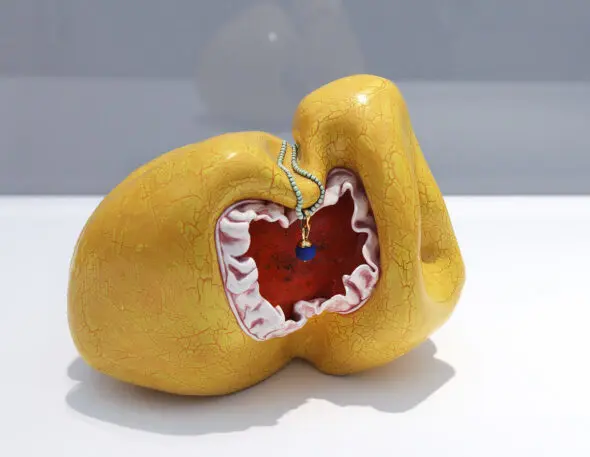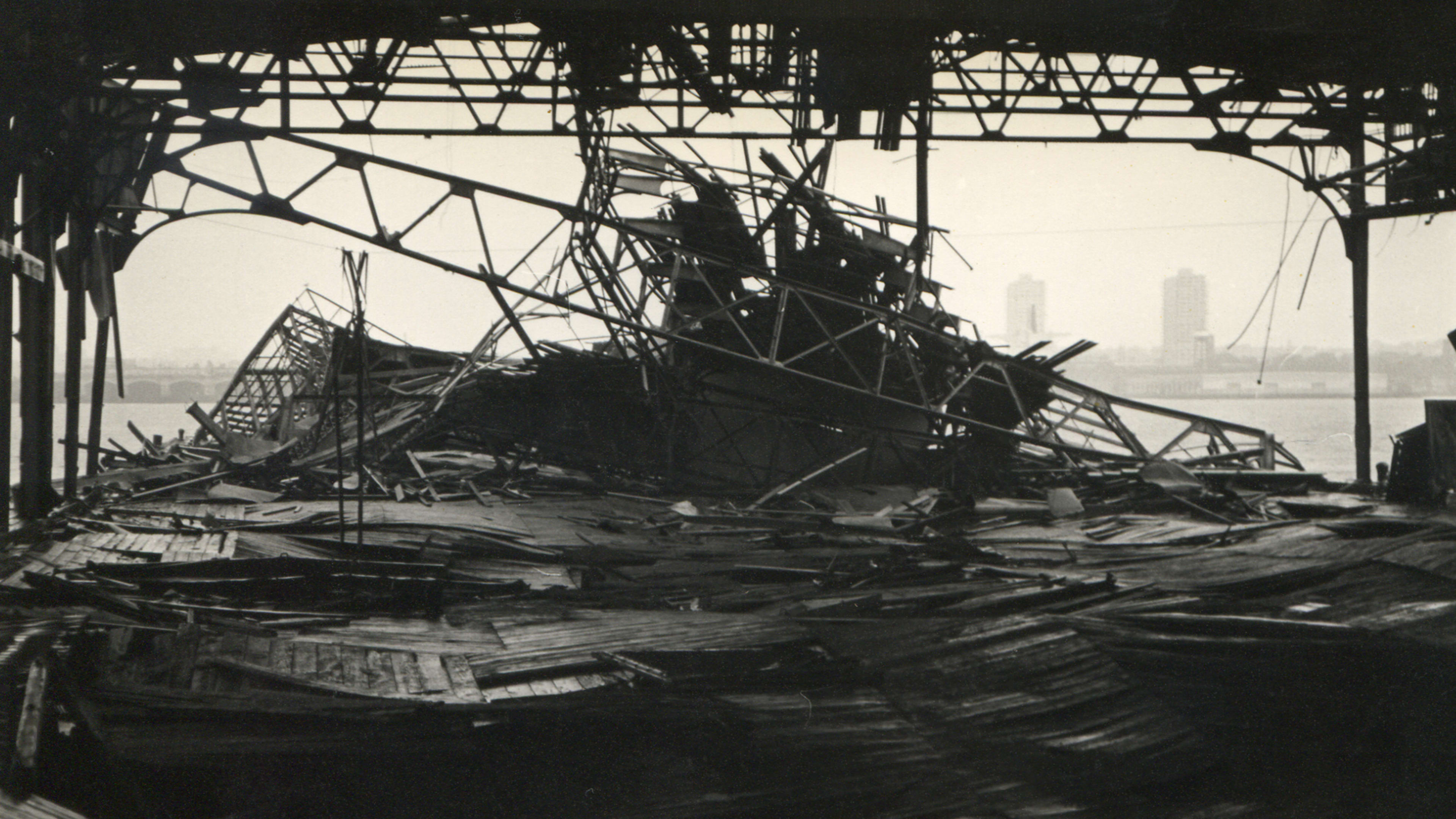Several weeks ago, I wandered into a room full of misshapen mouths, shrunken heads, and puckered orifices. They were yellow, pink, cherry red, and ebony. They were strange and exciting—entirely new to me. I hadn’t gone looking for those weird forms. I had simply been killing time before an interview at the Portland Museum of Art, and behind the galleries hung with works by Claude Monet and Winslow Homer, there was a large collection of ceramics on display.

The pieces were the work of Kathy Butterly, a relatively unsung New York-based artist and visionary whose porcelain vessels seek to inject a dose of “intimacy” into our “loud, TikTok, screenshotted world.” She explains, “My work feels right to me when it is both beautiful and uneasy . . . full of confidence in all of its awkwardness.”
It felt electric to see pieces so singular and yet so familiar; I knew the sag of deflated flesh when I saw it. I’ve breastfed a child. Yet the raw tenderness and uncomfortable beauty of Butterly’s works felt important in a way that I couldn’t name. Clarity came weeks later when I read “The Big Dissolve” by journalist Sangeeta Singh-Kurtz. Published on The Cut, the essay documents the fall of fillers among Hollywood elites. “Since 2016,” Singh-Kurtz writes, “millions of people have gone to dermatologists to put things in their faces with one particular goal: to look like sexy babies.”
Now, however, standards have shifted, and the popular face is no longer overstuffed and oh-so-soft. The new trendy procedure is buccal fat removal, which sharpens the angles of the face to a knife’s edge. The new coveted pharmaceutical is Ozempic, a diabetes drug which, when abused, can quell the appetite of an already thin body, allowing starvation-like levels of thinness to emerge from one’s fleshy form until their collarbones could slice a spaghetti strap.
Sharpness, stiffness, angles, bones—our appreciation for these qualities is nothing new. From the flappers of the 1920s to the Twiggy dresses of the ’60s and the so-called heroin-chic models of the 1990s, society has long appreciated white, thin, upper-crust androgyny and its stark prettiness. But often periods of thin worship are followed by decades of hourglass emphasis. Although the general confines of the pendulum swing for female beauty tend to be rather restrictive, the ideal does shift somewhat predictably from hyper-thin to less-thin.
According to conventional wisdom, the same seesaw movement we’re seeing in the corporal realm will echo throughout culture. A preference for hardness gives way to a fetishization of softness. It’s so easy to see the binaries, the poles between which we ping and pong. One can map these trends onto almost anything: fashion, design, art, bodies, politics. First there was minimalism, then came maximalism. We got tired of skinny jeans, thus entered flares. Chubby, playful design gets pushed aside in favor of stark, stripped-down elegance. It’s an addictive game to play, this pointy versus round.
Admittedly, I was among the Twitter masses cheering last February when an art collector accidentally knocked a $42,000 Jeff Koons sculpture off its pedestal in Miami. It felt cathartic to see the electric-blue remnants of the shattered Balloon Dog. It was the fall of an overstuffed icon, the puncturing of a consumerist bubble boy, and I don’t feel bad for laughing. But I’ve also begun to wonder: What if there were another way? What if our aesthetic categories didn’t feel so binary?
What if we weren’t trapped in an either/or system of fads and falls. What if there was more space in between the poles where we could play? And to take it a step further: What if collapse wasn’t considered tragic—what if sagging was an aesthetic, what if ruin and entropy and slow degradation didn’t feel so dispiriting and instead felt like a form worth celebrating, a source of joy?
Today we’re in the middle of a shift, perhaps a great deflation or maybe a big dissolve. It’s disorienting and regressive, but perhaps this messy middle ground could also provide an opportunity for reflection—maybe even acceptance.
While an aging face, a crumbling city, and a sagging ceramic may not seem directly connected, they all have been undone by the same basic forces. Like ancient glass slumping in a frame, these objects display the dragging, slow beauty of gravity. They defy the imperative to demolish and discard. They also deny the churn of newness, the clean pendulum swing of trends. They ask to freeze the unbuilt for a moment and revel in the undoing.
I believe in beauty, which is to say: I believe in the power of aesthetics. Appearance is important. Art is one way for a culture to explore its shared values, challenge its systems, and open new pathways of being. While my recent book, The Ugly History of Beautiful Things, focuses on the darkness hiding behind consumer objects, I don’t believe prettiness is doomed nor do I plan to opt out of the trend cycle entirely.
Like Marie Kondo, I love mess and crave order. These impulses coexist comfortably. There are aspects of our pendulum swing that I genuinely enjoy, though when it comes to bodies, I wish we could learn to see a wider range of humanity—not necessarily as beautiful, but as valid, compelling, worthy. Although we’re in a time of great, slow collapse and unprecedented melting, we haven’t really managed to embrace the more hopeful possibilities of our world undone, instead focusing on the apocalyptic visions.
Jack Halberstam of Columbia University has been arguing for an aesthetic of collapse for several years, with a focus on photography of the 1970s. “It’s a very particular argument that looks back to the 1970s and these artists who were working with a collapsed but rapidly being rebuilt city in New York,” Halberstam explains. “They were finding shapes that they liked in demolition sites and how things were falling down.”

The work of Alvin Baltrop can be read, Halberstam argues, as an eroticization of “unbuilding.” In images of ruin and sex, Baltrop presents a new form of masculinity and a new type of beauty, one that resists the capitalist model of boom or bust, rise and fall. “One of the things I was trying to say about Alvin Baltrop is that he was offering another side to masculinity that wasn’t about erection, but deflation,” Halberstam adds.
In a lecture for queer disrupt, Halberstam calls the aesthetic of collapse both queer and Black, a way of looking at the world that radically resists the status quo. In order to build utopia, Halberstam points out, one must first unbuild the systems that are oppressive. An aesthetic of collapse is one way of imagining this process—entropy as a wellspring for hope.
“I find the ruins fertile,” writes art critic A. V. Marraccini in her 2023 book, We the Parasites. “It makes things, art and pleasure.” Marraccini is writing about her role as a critic—a parasite—during the early days of quarantine. It was a time when things were in flux, when society was coming undone and cities were emptying. Ruins, she argues, are “productive.” They invite us to reimagine. A ruin could call for restoration, or it could provide shelter for new species. Ruins can also be seen as spaces that need nothing. A fallen form is not necessarily a tragedy. Choreographers know this well.
After answering my initial questions over email, the sculptor Butterly wrote to me with one final thought. “I’m in my studio and looking at my current works in their many different stages and I realize that there is an innocence to them,” she said. “They don’t really know that they are slumping or slashed open . . . they just kind of accept what they are and make the best of it. And they are kind of proud of what they are.”
When stripped of baggage and allowed to rest, our bodies can hold this same stately materiality. Our world can be collapsing but it could also be unbuilding, dying back, and waiting for the next great age to emerge.
Recognize your brand’s excellence by applying to this year’s Brands That Matter Awards before the early-rate deadline, May 3.
